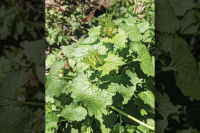Going forward by looking backward: Tradition and science meet in Cherokee forest plan
Over the course of thousands of years lived in the Southern Appalachian mountains, the Cherokee people had pretty well developed a system of relationship with the land that ensured they harvested what they needed to live while leaving enough to ensure future generations would yield the same benefit.
But then there was the arrival of Europeans, years of conflict, the removal, and the establishment of the Qualla Boundary under the supervision of the Bureau of Indian Affairs. It’s been a long time since Cherokee land was truly managed in the Cherokee tradition, but with the impending approval of a new forest management plan the pendulum is swinging back closer than it’s been in a long time.
Wilderness debate goes to the government
When the forest planning process for the Nantahala and Pisgah national forests kicked off more than two years ago, it didn’t take long for the question of wilderness designation — whether and how much more acreage should be recommended, which areas should make the cut — to rise to the top of the stack of contentious issues.
Congressman sits down with wilderness supporters
Congressman Mark Meadows (R-Cashiers) and a room of 30 wilderness supporters spent two hours discussing everything from ecology to U.S. Forest Service road budgets last week at the Haywood County Historic Courthouse with the goal of better understanding each other’s views on the purpose of wilderness designation.
“I will read everything you send me. I’m going to ask you questions,” Meadows promised as he closed out the meeting. “I’m trying to be as informed as I can.”
Forest Service evaluates potential wilderness areas
The cadre of groups helping the U.S. Forest Service work toward a new management plan for the Pisgah-Nantahala National Forest recently got a first peek at one of the most controversial aspects of the planning process — the proposals for new wilderness designation.
“This is the first real concrete opportunity we’ve had to see what the Forest Service is thinking,” said Richard Mode of the N.C. Wildlife Federation. “I’m thrilled to have an opportunity to look at them.”
Planning begins for logging project in Haywood
 Round tables and large, neon sticky notes characterized last week’s kickoff of a planning process to cut timber and create elk habitat in a remote corner of northeastern Haywood County.
Round tables and large, neon sticky notes characterized last week’s kickoff of a planning process to cut timber and create elk habitat in a remote corner of northeastern Haywood County.
About 50 people representing groups including the N.C. Wildlife Resources Commission, MountainTrue, The Nature Conservancy, the Ruffed Grouse Society and Haywood County government — among a host of others — found their way to the room at the N.C. Arboretum in Asheville, taking a seat on the large circle of chairs waiting for them.
Forest plan timeline lengthens
 The timeline for a draft forest management plan has been kicked back once more, with the document now expected sometime at the very end of 2016.
The timeline for a draft forest management plan has been kicked back once more, with the document now expected sometime at the very end of 2016.









